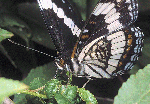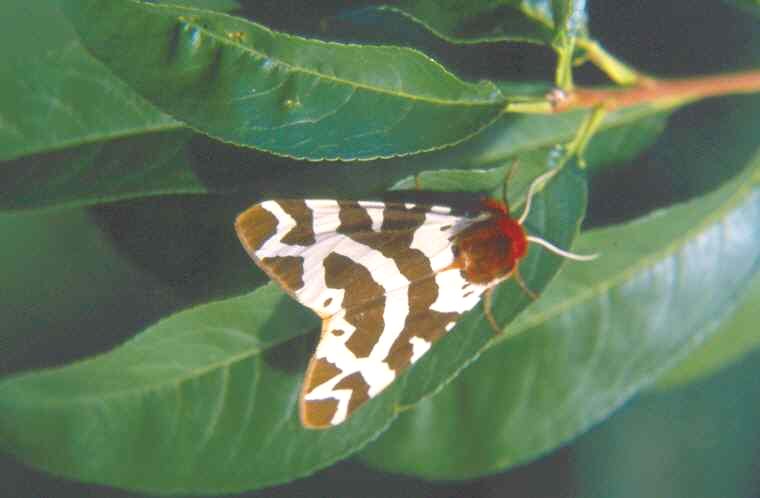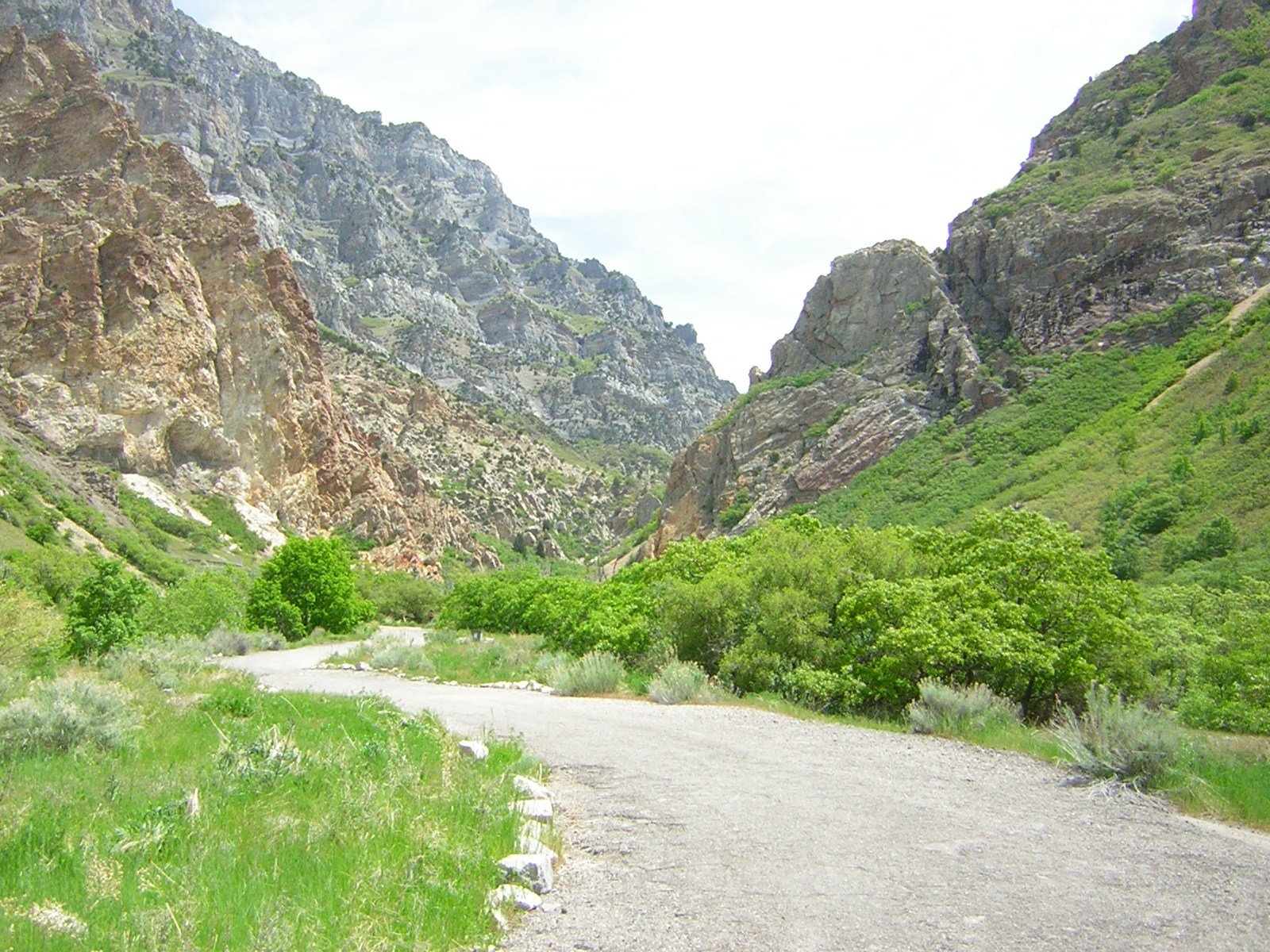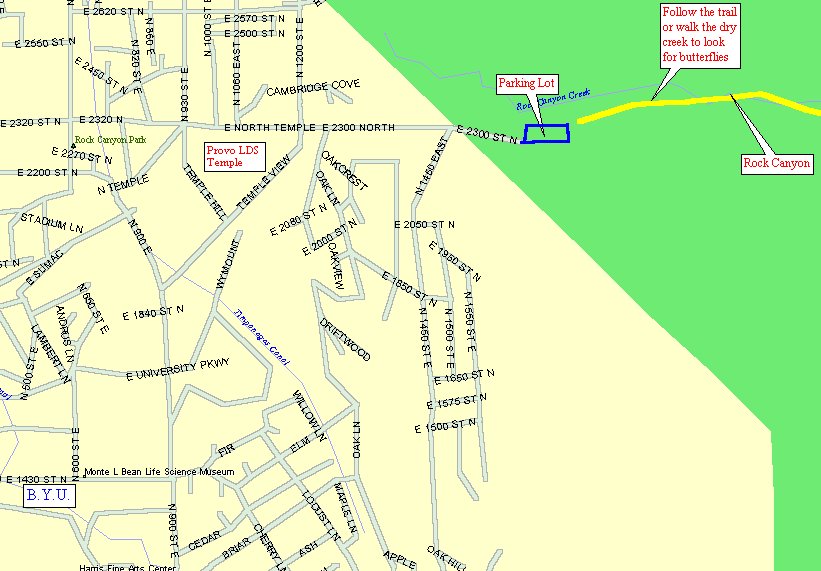
Utah Lepidopterists' Society
Founded 6 Nov 1976

|
|
Utah Lepidopterists' Society Founded 6 Nov 1976 |
|
| History | Mission | Meetings | Bulletin | Checklists | Links | Community | Field Trips | Habitat | Members | Kids | Contact Us |
Utah Habitats for Butterflies and Moths
Wasatch Canyons--Rock Canyon in Provo
 |
8. Montane 9. Utah's Dixie |

Nestled just to the East of the Provo Temple and Northeast of B.Y.U., Rock Canyon offers a wide variety of activities for naturalists from rock climbing to collecting butterflies and moths. (For a self-guided tour of Rock Canyon, click here.) Rock Canyon is a dry canyon with males of many species of butterflies patrolling up and down the dry wash and nearby road.
|
|
During March, some of the species you may find flying in Rock Canyon on a sunny, 50+ degree day include some of our overwintering nymphalids such as the Mourning Cloak (Nymphalis antiopa,) Milbert's Tortoiseshell (Nymphalis milberti furcillata,) Satyr Comma (Polygonia satyrus satyrus,) and/or Hoary Comma (Polygonia zephyrus.) Towards the end of March, the Checkered White (Pieris protodice,) flies accompanied soon thereafter by the very common moth, Litocala sexsignata; which becomes quite abundant in the canyon. |
During the warmth of mid-April, several butterfly species of swallowtails, blues, and whites emerge, and begin to fly. These species include the Anise Swallowtail (Papilio zelicaon nitra,) Spring White (Pieris sisymbri sisymbri,) Utah Stella Orangetip (Anthocharis stella browningi,) Large Marble (Euchloe ausonides coloradensis,) Yellow Sulphur (Colias philodice eriphyle,) Silvery Blue (Glaucopsyche lygdamus oro,) and Thistle Crescent (Phyciodes mylitta mylitta.) Flying with the Utah Stella Orange-tip (Anthocharis stella browningi,) you may find an occasional Southwestern Orangetip (Anthocharis sara thoosa) flying. This has been a recent development as the Southwestern Orangetip is mostly found in Utah's Basin and Range Province such as the hills behind Cedar Fort.
Towards the end of April, skippers such as the Sleepy Duskywing (Erynnis brizo burgessi,) Rocky Mountain Duskywing (Erynnis telemachus,) the Common Checkered-Skipper (Pyrgus communis,) and the Juba Skipper (Hesperia juba) start flying.
A special note about the Spring White (Pieris sisymbri sisymbri:) You need to climb the side of the mountain towards hilltops to find males of this butterfly ascending towards the top. As you do so, you may find a few males of the Anise Swallowtail (Papilio zelicaon gothica,) behaving similarly.
During the first week of May, keep a look out for Queen Alexandra's Sulphur (Colias alexandra alexandra.) It is a large yellow sulphur that loves to tease collectors as it flies along the hillside . Its males do not traverse Rock Canyon. They fly vertically up and down the mountainside in search for females who are not too far away from the larval hostplant--Astragalus ssp.
Other species that start flying in early May, whose males do fly right along this dry canyon are the Two-tailed Swallowtail (Papilio multicaudata pusillus,) Melissa Blue (Plebejus melissa melissa,) Sagebrush Checkerspot (Chlosyne acastus acastus,) Field Crescent (Phyciodes pulchella camillus,) and the Northern Cloudywing (Thorybes pylades pylades.)
Towards the end of May, other species that may start flying along the canyon is the Western Tiger Swallowtail (Papilio rutulus rutulus,) Gray Hairstreak (Strymon melinus franki,) Coronis Fritillary (Speyeria coronis snyderi,) Callippe Fritillary (Speyeria callippe harmonia,) Pale Crescent (Phyciodes pallida barnesi,) Variable Checkerspot (Euphydryas anicia maria,) Painted Lady (Vanessa cardui,) Red Admiral (Vanessa atalanta rubria,) Weidemeyer's Admiral (Limenitis weidemeyeri latifascia,) and the Common Ringlet (Coenonympha tullia brenda.)
During the month of June, other species of fritillaries begin to fly such as the Great Basin Fritillary (Speyeria egleis utahensis,) Northwestern Fritillary (Speyeria hesperis wasatchia,) which fly along with the Northern Crescent (Phyciodes cocyta.)
The month of June also provides the first, almost unnoticeable, flight of the Arizona Sister (Adelpha bredowi eulalia.) This butterfly becomes much more noticeable in the canyon as its numbers usually increase during its second flight which occurs in the fall.
Occasionally, during June, some males of the Clodius Parnassian or American Red Pearl (Parnassius clodius menetriesi) and the Pale Swallowtail (Papilio eurymedon) will descend from higher elevations of the canyon to fly in the mouth of the canyon. However, in order to find more individuals of these two species, you're probably better off traveling to Provo Canyon, and then taking Squaw Peak Road back to Rock Canyon Campground.
Population numbers of all three "glaucus" group swallowtails, Papilio rutulus rutulus, Papilio multicaudata pusillus, and Papilio eurymedon, which can provide a prized "catch" for children, can vary drastically from year to year because of a yellow wasp that can parasitize their larvae. During May of 2003, very few individuals of the Pale Swallowtail were seen out in the field. Furthermore, what few caterpillars that were found on its hostplant, Ceanothus velutinus, were mostly parasitized by this wasp.
Just as population numbers of butterflies dip when their parasites increase, later, the reverse invariably occurs as numbers of the parasites dip as butterfly numbers recover. Sometimes butterfly population numbers can explode before the parasites can catch up and repeat the cycle again.
Towards, the end of June, you will start finding a butterfly that seems to prefer to dance within the shady confines of the Scrub Oak than out in the open canyon with the rest of the butterflies. This butterfly is the Great Basin Wood Nymph (Cercyonis sthenele masoni.) Because this butterfly flies within and around the scrub oaks, they seem to get tattered and chipped faster than most other species of butterflies in the canyon; thus making collecting or photographing quite difficult.
Butterfly Species Checklist For Rock Canyon:
Swallowtails (Family Papilionidae)
|
Brush-footed Butterflies (Family Nymphalidae)
|
Gossamer-wing Butterflies (Family Lycaenidae)
|
Milkweed Butterflies (Family Danaidae)
|
Skippers (Family Hesperiidae)
|
Whites and Sulphurs (Family Pieridae)
|
All images of Limenitis weidemeyeri on the ULS Info Bar courtesy Jay Cossey
|
|